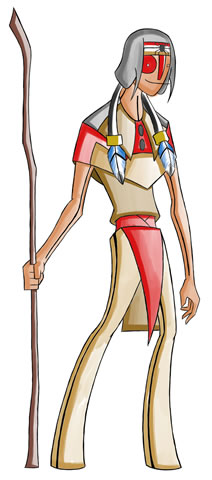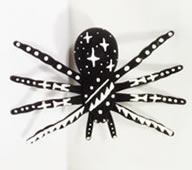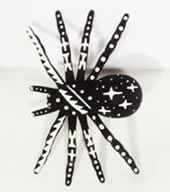 |
Canku Ota
|
 |
|
(Many Paths)
|
||
|
An Online Newsletter
Celebrating Native America
|
||
|
March 2013 - Volume
11 Number 3
|
||
|
|
||
|
Native American Ghost
Stories
|
||
|
by Ruth Hopkins - Indian
Country Today Media Network.com
|
||
|
Every Native has a ghost story to tell. I use the term ghost loosely, as we are a spiritual people with strong belief systems. Our ghost stories may involve spirits that mainstream culture refers to as ghosts, but they may also include personal accounts of encounters with bigfoot, deer woman, or spirit beings like skinwalkers, little people, Iktomi (the Trickster), or even something no one has ever heard of before. Do these things exist? I have no proof in the western scientific sense, although I do know quite a few honest people who’ve had supernatural experiences they cannot explain, or who believe they’ve interacted with ancestral spirits through prayer and ceremony. My dad always said that he thought Indigenous peoples were more sensitive to supernatural phenomenon. He said it was because we were closer to our origins, and thus closer to ‘the veil’ that divides our living physical world from the spirit world, as well as other dimensions. The Native perspective of spirituality does differ from that of the mainstream. Western culture separates spirituality from other aspects of life, if they believe the spirit exists at all. Traditionally, Natives believe that the spirit realm exists, although we may have a limited understanding of it as human beings. We don’t cord off spirituality from the rest of our life either. Indeed, walking the sacred red road demands that one understands that all things are connected: mitakuye oyasin. Like most Natives, I grew up hearing ghost stories. When I reflect on them, I realize that some of them serve a purpose. When I was a teenager growing up on the reservation, an old, abandoned house across the lake was pointed out to me. I was told that a man once lived there who practiced love medicine. He stole girl’s hair and used magic to make them fall in love with him. Then he used them and cast them aside after he grew tired of them. This story scared the daylights out of me- but at the same time it also enforced Tribal cultural teachings about caring for one’s hair and told me a little something about the different types of medicine people practiced. It also warned me of the danger of getting involved with men who might seek to take advantage of me.
Like the #IdleNoMore Twitter phenomenon has shown us, Natives are becoming masters of social media. This technological adaptation has merged with our love of sharing and storytelling to create pages where Natives post stories online and provide each other with feedback. The Facebook community page, Native Ghost Stories, is one such venue. While the page was just created on January 9, 2013, it’s taken off and currently boasts a following of over 21,000 people. The page is posting ghost stories from Natives of every Tribe, from all over North America. Once you begin reading the stories, you may find it difficult to leave. Accounts of the spirits of long dead Native children who play in abandoned boarding schools are heart wrenching, while others describing encounters with inhuman spirits are downright hair raising. By the way, the page has pictures too. Whether you deem the material posted on the page as legitimate is your choice, but it’s definitely engaging and you’ll learn more about Native people and our experiences while you’re there. Whether they realize it or not, those who participate in this Facebook page and others like it are assisting in the advancement of a primary tool of cultural preservation: storytelling. How exciting. Yes, the modes of transmission and venues may have changed, but the millennia-old tradition of storytelling still runs strong among our people. Now pardon me while I take a moment to burn some sage and smudge off. Ruth Hopkins (Sisseton-Wahpeton and Mdewakanton Dakota, Hunkpapa Lakota) is a writer, blogger, ethnoscientist, Tribal Judge for the Sisseton Wahpeton Oyate, and the Tribal Colleges Liaison Manager for the University of North Dakota (UND) and North Dakota State University (NDSU) via North Dakota EPSCoR (Experimental Program to Stimulate Competitive Research). Her first horror novella will be released in 2013. Follow her on Twitter.
|
|||||||
|
|
||
|
|
||
| Canku Ota is a free Newsletter celebrating Native America, its traditions and accomplishments . We do not provide subscriber or visitor names to anyone. Some articles presented in Canku Ota may contain copyright material. We have received appropriate permissions for republishing any articles. Material appearing here is distributed without profit or monetary gain to those who have expressed an interest. This is in accordance with Title 17 U.S.C. Section 107. | ||
|
Canku Ota is a copyright ©
2000 - 2013 of Vicki Williams Barry and Paul Barry.
|
||
 |
 |
|
|
The "Canku
Ota - A Newsletter Celebrating Native America" web site and
its design is the
|
||
|
Copyright ©
1999 - 2013 of Paul C. Barry.
|
||
|
All Rights Reserved.
|
||
 Once
upon a time, Natives gathered around a campfire to share stories.
While these tales were used to educate, instill values, and preserve
culture and history, they also provided us with a means of creative
expression and intellectual dialogue, and they were entertaining
too. In its purest form, ancient Native storytellers were some of
mankind’s earliest improv performers, and a little embellishment
was par for the course. We had a story for everything, from how
constellations and landmarks formed, to wanagi (spirit) tales.
Once
upon a time, Natives gathered around a campfire to share stories.
While these tales were used to educate, instill values, and preserve
culture and history, they also provided us with a means of creative
expression and intellectual dialogue, and they were entertaining
too. In its purest form, ancient Native storytellers were some of
mankind’s earliest improv performers, and a little embellishment
was par for the course. We had a story for everything, from how
constellations and landmarks formed, to wanagi (spirit) tales. Another
common rez legend (as opposed to urban legends) in the northern
plains is about sacred little people who terrorize anyone who’s
getting drunk, especially out in nature. While the scenario and
characters often change, surely this story has discouraged a few
underage Natives from driving off into the country to party.
Another
common rez legend (as opposed to urban legends) in the northern
plains is about sacred little people who terrorize anyone who’s
getting drunk, especially out in nature. While the scenario and
characters often change, surely this story has discouraged a few
underage Natives from driving off into the country to party.



